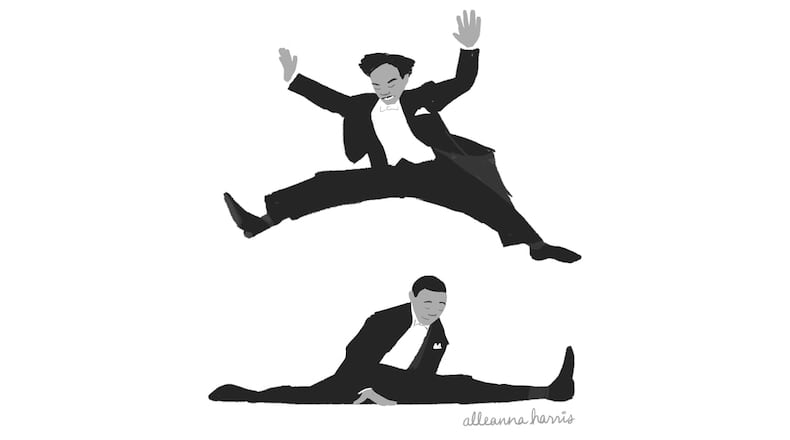During the month of February, The Atlanta Journal-Constitution will publish a daily feature highlighting African American contributions to our state and nation. This is the fifth year of the AJC Sepia Black History Month series. In addition to the daily feature, the AJC also will publish deeper examinations of contemporary African American life each Sunday.
The old adage “practice makes perfect” may be an essential piece of the learning puzzle for most performers, but the Nicholas Brothers were an exception.
The acrobatic tap duo’s iconic scene from the 1943 musical “Stormy Weather” is considered one of the greatest dance sequences ever, and it was unrehearsed and filmed in just one take.
For nearly three minutes, brothers Fayard and Harold Nicholas twist and turn across the stage to Cab Calloway’s “Jumpin’ Jive.” Mere seconds into their number, they hop onto the musicians’ tables and gracefully switch between the surfaces.
» MORE: Full coverage of Black History Month
But perhaps the most unforgettable moment occurs when they descend down an elaborate staircase.
Step by step, they leapfrog over each other, landing in their signature no-hands split.
They then climb to the top again.
This time, they reach the bottom by sliding down the ramps of the staircase in yet another split. Before they take their final bow, they’re met with roaring applause.
In his latest book, “Hollywood Black,” film historian Donald Bogle called the brothers “possibly the two greatest dancers in Hollywood, (who) performed an energetic, dazzling climactic staircase number that took dance cinema to new heights.”
“We never rehearsed it, but we could picture in our minds what we were really supposed to do and we started doing it one step after another over each other’s heads,” Fayard Nicholas said in the 1992 award-winning documentary “The Nicholas Brothers: We Sing and We Dance.” “And Nick Castle, our dance director, said, ‘Cut. That’s it. You cannot get it any better.’”
In 2017, Alleanna Harris, a New Jersey-based children's book illustrator, captured the sequence — painting Harold in mid-flight leaping over Fayard, who had just hit his split — for a Black History Month series she was working on.
"I wanted to do different influential figures that many people may have heard of before that I thought would be fun to draw," said Harris, whose latest book, "Making Their Voices Heard," deals with the relationship between Marilyn Monroe and Ella Fitzgerald. "I have a thing for movement in illustration and I was attracted to their movements."
Fayard Nicholas, born Oct. 20, 1914, in Mobile, Alabama, and Harold Nicholas, born March 17, 1921, in Winston-Salem, North Carolina, began dazzling audiences as boys. At a young age, the sons of college-educated musicians were exposed to dozens of vaudeville acts at the Philadelphia theater where their parents played.
Fascinated by the dancers and singers, Fayard Nicholas began to imitate the professionals. He then taught his younger siblings, Dorothy and Harold Nicholas, first performing with them as the Nicholas Kids.
»RELATED: Josephine Baker’s greatness
When Dorothy Nicholas dropped out, he and Harold Nicholas became the Nicholas Brothers.
Despite their lack of formal training, they developed a unique style that combined tap, jazz, ballet and acrobatics.
As they danced around Philadelphia, their local celebrity grew quickly.
» RELATED: Atlanta Ballet and Alvin Ailey: different paths, common goal
They started to gain national attention in 1932 when they were hired at ages 18 and 11 to wow folks at Harlem’s renowned Cotton Club. They shared the spotlight with legends like Duke Ellington, Ethel Waters and Lucky Millinder, until the famous spot closed in 1940.
They eventually headed west, making their Hollywood film debut in 1934’s “Kid Millions.” For about a decade, the brothers steadily appeared together in a string of Broadway productions, television shows and motion pictures, including “The Big Broadcast of 1936,” “Orchestra Wives” and “The Pirate.”
But despite their stardom, the two still faced racism. They were sometimes told to remain in their dressing rooms until showtime and were often overlooked for leading acting and singing roles.
“All the great songs that were written in those days when I was coming up, I learned them all. But I never got a chance to really sing them like I wanted to on the stage in front of an audience,” Harold Nicholas said in the documentary. “That was kind of hard for me, because I thought about it a lot like why won’t they let me sing. Because we were dancers, they said.”
Frustrated with the racial restrictions in America, the Nicholas Brothers made Europe their home for parts of the 1940s and ’50s. Crowds continued to embrace the international stars even when they performed as soloists.
They separated for about seven years but reunited in the States, where they remained a hot commodity as both entertainers and teachers well into their 70s.
»RELATED: How Ella Fitzgerald became the most celebrated jazz singer of her generation
Among their students — and fans — were Debbie Allen, Janet Jackson, Michael Jackson and Gregory Hines, who once said if their biography were ever filmed, their choreography would have to be computer-generated because no one could emulate them.
Toward the end of their 60-plus-year careers, the brothers traveled the world throughout the 1980s and ’90s collecting awards, such as Kennedy Center Honors and a star on the Hollywood Walk of Fame.
Harold Nicholas died in 2000 at 79, and Fayard Nicholas died in 2006 at 91.
Although their remarkable style of dancing is no longer popular, clips of their iconic routines frequently end up on social media, where they still receive the praise they deserve in the form of retweets and likes.
It’s further proof that their legacies are unmatched and that they will remain dance heroes for generations to come.
BLACK HISTORY MONTH
Throughout February, we’ll spotlight a different African American pioneer in the Living section every day except Fridays. The stories will run in the Metro section on that day.
Go to www.ajc.com/black-history-month/ for more subscriber exclusives on people, places and organizations that have changed the world and to see videos and listen to Spotify playlists on featured African American pioneers.
About the Author
Keep Reading
The Latest
Featured


